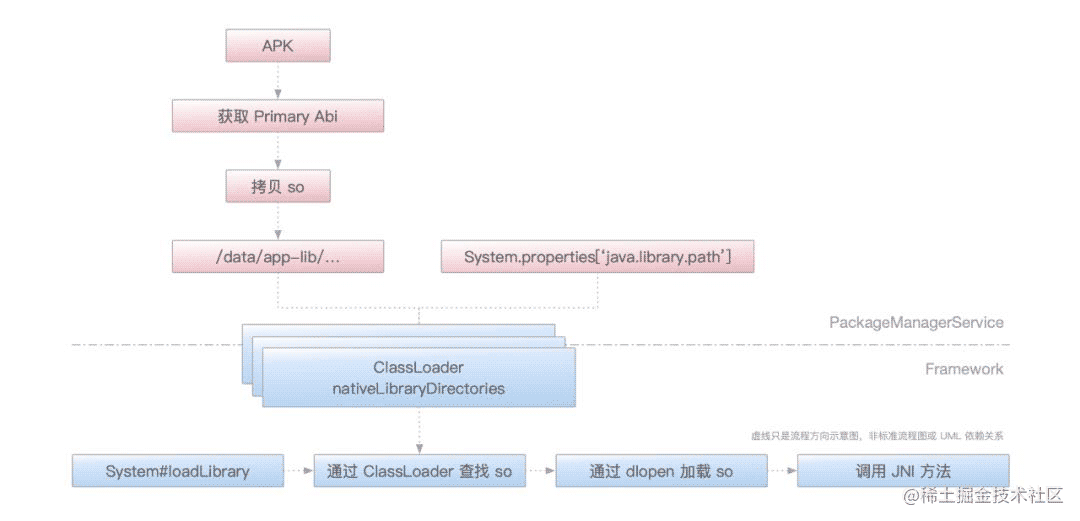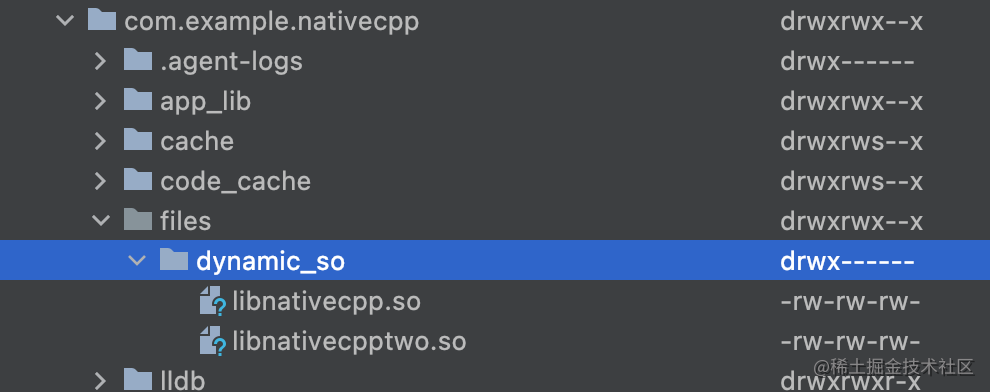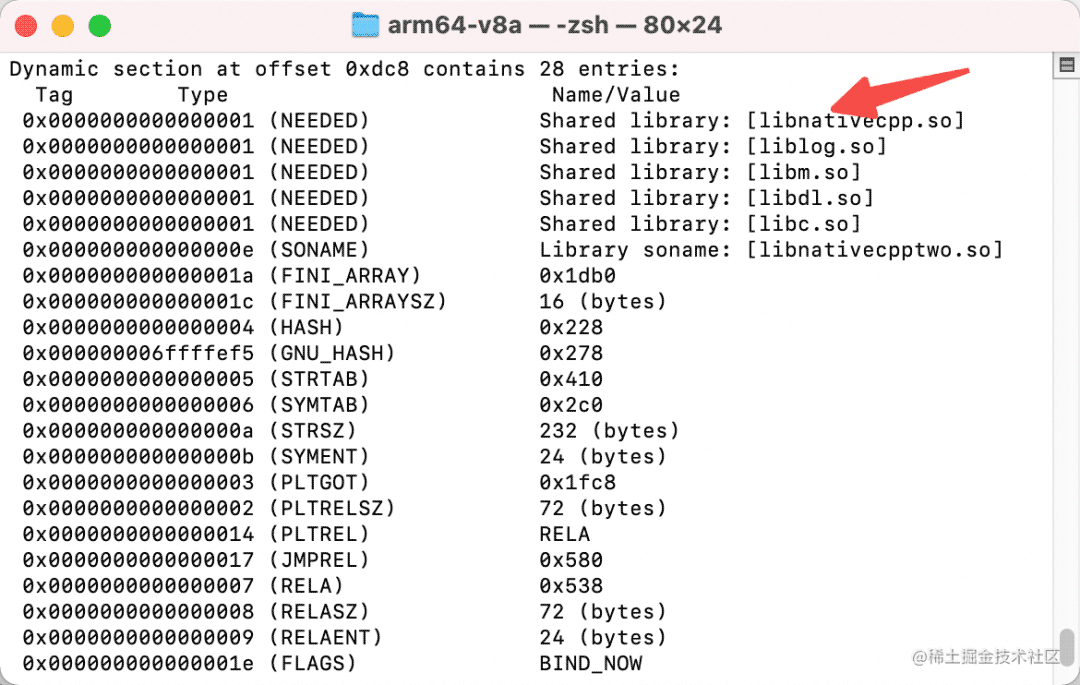我们帮大家精选了相关的编程文章,网友杜含娇根据主题投稿了本篇教程内容,涉及到Android、动态加载、so、Android、so、Android 动态加载 so相关内容,已被309网友关注,下面的电子资料对本篇知识点有更加详尽的解释。
Android 动态加载 so
背景
对于一个普通的android应用来说,so库的占比通常都是巨高不下的,因为我们无可避免的在开发中遇到各种各样需要用到native的需求,所以so库的动态化可以减少极大的包体积,自从2020腾讯的bugly团队发部关于动态化so的相关文章后,已经过去两年了,相关文章,经过两年的考验,实际上so动态加载也是非常成熟的一项技术了。
但是很遗憾,许多公司都还没有这方面的涉略又或者说不知道从哪里开始进行,因为so动态其实涉及到下载,so版本管理,动态加载实现等多方面,我们不妨抛开这些额外的东西,从最本质的so动态加载出发吧!这里是本次的例子,我把它命名为sillyboy,欢迎pr还有后续点赞呀!
so动态加载介绍
动态加载,其实就是把我们的so库在打包成apk的时候剔除,在合适的时候通过网络包下载的方式,通过一些手段,在运行的时候进行分离加载的过程。
这里涉及到下载器,还有下载后的版本管理等等确保一个so库被正确的加载等过程,在这里,我们不讨论这些辅助的流程,我们看下怎么实现一个最简单的加载流程。

从一个例子出发
我们构建一个native工程,然后在里面编入如下内容,下面是cmake
# For more information about using CMake with Android Studio, read the
# documentation: https://d.android.com/studio/projects/add-native-code.html
# Sets the minimum version of CMake required to build the native library.
cmake_minimum_required(VERSION 3.18.1)
# Declares and names the project.
project("nativecpp")
# Creates and names a library, sets it as either STATIC
# or SHARED, and provides the relative paths to its source code.
# You can define multiple libraries, and CMake builds them for you.
# Gradle automatically packages shared libraries with your APK.
add_library( # Sets the name of the library.
nativecpp
# Sets the library as a shared library.
SHARED
# Provides a relative path to your source file(s).
native-lib.cpp)
add_library(
nativecpptwo
SHARED
test.cpp
)
# Searches for a specified prebuilt library and stores the path as a
# variable. Because CMake includes system libraries in the search path by
# default, you only need to specify the name of the public NDK library
# you want to add. CMake verifies that the library exists before
# completing its build.
find_libHrary( # Sets the name of the path variable.
log-lib
# Specifies the name of the NDK library that
# you want CMake to locate.
log)
# Specifies libraries CMake should link to your target library. You
# can link multiple libraries, such as libraries you define in this
# build script, prebuilt third-party libraries, or system libraries.
target_link_libraries( # Specifies the target library.
nativecpp
# Links the target library to the log library
# included in the NDK.
${log-lib})
target_link_libraries( # Specifies the target library.
nativecpptwo
# Links the target library to the log library
# included in the NDK.
nativecpp
${log-lib})可以看到,我们生成了两个so库一个是nativecpp,还有一个是nativecpptwo(为什么要两个呢?我们可以继续看下文) 这里也给出最关键的test.cpp代码
#include#include #include extern "C" JNIEXPORT void JNICALL Java_com_example_nativecpp_MainActivity_clickTest(JNIEnv *env, jobject thiz) { // 在这里打印一句话 __android_log_print(ANDROID_LOG_INFO,"hello"," native 层方法"); }
很简单,就一个native方法,打印一个log即可,我们就可以在java/kotin层进行方法调用了,即
public native void clickTest();
so库检索与删除
要实现so的动态加载,那最起码是要知道本项目过程中涉及到哪些so吧!不用担心,我们gradle构建的时候,就已经提供了相应的构建过程,即构建的task【 mergeDebugNativeLibs】,在这个过程中,会把一个project里面的所有native库进行一个收集的过程,紧接着task【stripDebugDebugSymbols】是一个符号表清除过程,如果了解native开发的朋友很容易就知道,这就是一个减少so体积的一个过程,我们不在这里详述。
所以我们很容易想到,我们只要在这两个task中插入一个自定义的task,用于遍历和删除就可以实现so的删除化了,所以就很容易写出这样的代码
ext {
deleteSoName = ["libnativecpptwo.so","libnativecpp.so"]
}
// 这个是初始化 -配置 -执行阶段中,配置阶段执行的任务之一,完成afterEvaluate就可以得到所有的tasks,从而可以在里面插入我们定制化的数据
task(dynamicSo) {
}.doLast {
println("dynamicSo insert!!!! ")
//projectDir 在哪个project下面,projectDir就是哪个路径
print(getRootProject().findAll())
def file = new File("${projectDir}/build/intermediates/merged_native_libs/debug/out/lib")
//默认删除所有的so库
if (file.exists()) {
file.listFiles().each {
if (it.isDirectory()) {
it.listFiles().each {
target ->
print("file ${target.name}")
def compareName = target.name
deleteSoName.each { if (compareName.contains(it)) { target.delete() }
}
}
}
}
} else {
print("nil")
}
}
afterEvaluate {
print("dynamicSo task start")
def customer = tasks.findByName("dynamicSo")
def merge = tasks.findByName("mergeDebugNativeLibs")
def strip = tasks.findByName("stripDebugDebugSymbols")
if (merge != null || strip != null) {
customer.mustRunAfter(merge)
strip.dependsOn(customer)
}
}可以看到,我们定义了一个自定义task dynamicSo,它的执行是在afterEvaluate中定义的,并且依赖于mergeDebugNativeLibs,而stripDebugDebugSymbols就依赖于我们生成的dynamicSo,达到了一个插入操作。
那么为什么要在afterEvaluate中执行呢?那是因为android插件是在配置阶段中才生成的mergeDebugNativeLibs等任务,原本的gradle构建是不存在这样一个任务的,所以我们才需要在配置完所有task之后,才进行的插入,我们可以看一下gradle的生命周期

通过对条件检索,我们就删除掉了我们想要的so,即ibnativecpptwo.so与libnativecpp.so。
动态加载so
根据上文检索出来的两个so,我们就可以在项目中上传到自己的后端中,然后通过网络下载到用户的手机上,这里我们就演示一下即可,我们就直接放在data目录下面吧

真实的项目过程中,应该要有校验操作,比如md5校验或者可以解压等等操作,这里不是重点,我们就直接略过啦!
那么,怎么把一个so库加载到我们本来的apk中呢?这里是so原本的加载过程,可以看到,系统是通过classloader检索native目录是否存在so库进行加载的,那我们反射一下,把我们自定义的path加入进行不就可以了吗?这里采用tinker一样的思路,在我们的classloader中加入so的检索路径即可,比如
private static final class V25 {
private static void install(ClassLoader classLoader, File folder) throws Throwable {
final Field pathListField = ShareReflectUtil.findField(classLoader, "pathList");
final Object dexPathList = pathListField.get(classLoader);
final Field nativeLibraryDirectories = ShareReflectUtil.findField(dexPathList, "nativeLibraryDirectories");
List origLibDirs = (List) nativeLibraryDirectories.get(dexPathList);
if (origLibDirs == null) {
origLibDirs = new ArrayList<>(2);
}
final Iterator libDirIt = origLibDirs.iterator();
while (libDirIt.hasNext()) {
final File libDir = libDirIt.next();
if (folder.equals(libDir)) {
libDirIt.remove();
break;
}
}
origLibDirs.add(0, folder);
final Field systemNativeLibraryDirectories = ShareReflectUtil.findField(dexPathList, "systemNativeLibraryDirectories");
List origSystemLibDirs = (List) systemNativeLibraryDirectories.get(dexPathList);
if (origSystemLibDirs == null) {
origSystemLibDirs = new ArrayList<>(2);
}
final List newLibDirs = new ArrayList<>(origLibDirs.size() + origSystemLibDirs.size() + 1);
newLibDirs.addAll(origLibDirs);
newLibDirs.addAll(origSystemLibDirs);
final Method makeElements = ShareReflectUtil.findMethod(dexPathList, "makePathElements", List.class);
final Object[] elements = (Object[]) makeElements.invoke(dexPathList, newLibDirs);
final Field nativeLibraryPathElements = ShareReflectUtil.findField(dexPathList, "nativeLibraryPathElements");
nativeLibraryPathElements.set(dexPathList, elements);
}
} 我们在原本的检索路径中,在最前面,即数组为0的位置加入了我们的检索路径,这样一来classloader在查找我们已经动态化的so库的时候,就能够找到!
结束了吗?
一般的so库,比如不依赖其他的so的时候,直接这样加载就没问题了,但是如果存在着依赖的so库的话,就不行了!相信大家在看其他的博客的时候就能看到,是因为Namespace的问题。具体是我们动态库加载的过程中,如果需要依赖其他的动态库,那么就需要一个链接的过程对吧!
这里的实现就是Linker,Linker 里检索的路径在创建 ClassLoader 实例后就被系统通过 Namespace 机制绑定了,当我们注入新的路径之后,虽然 ClassLoader 里的路径增加了,但是 Linker 里 Namespace 已经绑定的路径集合并没有同步更新,所以出现了 libxxx.so 文件(当前的so)能找到,而依赖的so 找不到的情况。bugly文章
很多实现都采用了Tinker的实现,既然我们系统的classloader是这样,那么我们在合适的时候把这个替换掉不就可以了嘛!当然bugly团队就是这样做的,但是笔者认为,替换一个classloader显然对于一个普通应用来说,成本还是太大了,而且兼容性风险也挺高的,当然,还有很多方式,比如采用Relinker这个库自定义我们加载的逻辑。
为了不冷饭热炒,嘿嘿,虽然我也喜欢吃炒饭(手动狗头),这里我们就不采用替换classloader的方式,而是采用跟relinker的思想,去进行加载!
具体的可以看到sillyboy的实现,其实就不依赖relinker跟tinker,因为我把关键的拷贝过来了,哈哈哈,好啦,我们看下怎么实现吧!不过在此这前,我们需要了解一些前置知识
ELF文件
我们的so库,本质就是一个elf文件,那么so库也符合elf文件的格式,ELF文件由4部分组成,分别是ELF头(ELF header)、程序头表(Program header table)、节(Section)和节头表(Section header table)。
实际上,一个文件中不一定包含全部内容,而且它们的位置也未必如同所示这样安排,只有ELF头的位置是固定的,其余各部分的位置、大小等信息由ELF头中的各项值来决定。

那么我们so中,如果依赖于其他的so,那么这个信息存在哪里呢!?没错,它其实也存在elf文件中,不然链接器怎么找嘛,它其实就存在.dynamic段中,所以我们只要找打dynamic段的偏移,就能到dynamic中,而被依赖的so的信息,其实就存在里面啦 我们可以用readelf(ndk中就有toolchains目录后) 查看,readelf -d nativecpptwo.so 这里的 -d 就是查看dynamic段的意思

这里面涉及到动态加载so的知识,可以推荐大家一本书,叫做程序员的自我修养-链接装载与库这里就画个初略图

我们再看下本质,dynamic结构体如下,定义在elf.h中
typedef struct{
Elf32_Sword d_tag;
union{
Elf32_Addr d_ptr;
....
}
}当d_tag的数值为DT_NEEDED的时候,就代表着依赖的共享对象文件,d_ptr表示所依赖的共享对象的文件名。看到这里读者们已经知道了,如果我们知道了文件名,不就可以再用System.loadLibrary去加载这个文件名确定的so了嘛!不用替换classloader就能够保证被依赖的库先加载!我们可以再总结一下这个方案的原理,如图

比如我们要加载so3,我们就需要先加载so2,如果so2存在依赖,那我们就调用System.loadLibrary先加载so1,这个时候so1就不存在依赖项了,就不需要再调用Linker去查找其他so库了。我们最终方案就是,只要能够解析对应的elf文件,然后找偏移,找到需要的目标项(DT_NEED)所对应的数值(即被依赖的so文件名)就可以了
public ListparseNeededDependencies() throws IOException { channel.position(0); final List dependencies = new ArrayList (); final Header header = parseHeader(); final ByteBuffer buffer = ByteBuffer.allocate(8); buffer.order(header.bigEndian ? ByteOrder.BIG_ENDIAN : ByteOrder.LITTLE_ENDIAN); long numProgramHeaderEntries = header.phnum; if (numProgramHeaderEntries == 0xFFFF) { /** * Extended Numbering * * If the real number of program header table entries is larger than * or equal to PN_XNUM(0xffff), it is set to sh_info field of the * section header at index 0, and PN_XNUM is set to e_phnum * field. Otherwise, the section header at index 0 is zero * initialized, if it exists. **/ final SectionHeader sectionHeader = header.getSectionHeader(0); numProgramHeaderEntries = sectionHeader.info; } long dynamicSectionOff = 0; for (long i = 0; i < numProgramHeaderEntries; ++i) { final ProgramHeader programHeader = header.getProgramHeader(i); if (programHeader.type == ProgramHeader.PT_DYNAMIC) { dynamicSectionOff = programHeader.offset; break; } } if (dynamicSectionOff == 0) { // No dynamic linking info, nothing to load return Collections.unmodifiableList(dependencies); } int i = 0; final List neededOffsets = new ArrayList (); long vStringTableOff = 0; DynamicStructure dynStructure; do { dynStructure = header.getDynamicStructure(dynamicSectionOff, i); if (dynStructure.tag == DynamicStructure.DT_NEEDED) { neededOffsets.add(dynStructure.val); } else if (dynStructure.tag == DynamicStructure.DT_STRTAB) { vStringTableOff = dynStructure.val; // d_ptr union } ++i; } while (dynStructure.tag != DynamicStructure.DT_NULL); if (vStringTableOff == 0) { throw new IllegalStateException("String table offset not found!"); } // Map to file offset final long stringTableOff = offsetFromVma(header, numProgramHeaderEntries, vStringTableOff); for (final Long strOff : neededOffsets) { dependencies.add(readString(buffer, stringTableOff + strOff)); } return dependencies; }
扩展
我们到这里,就能够解决so库的动态加载的相关问题了,那么还有人可能会问,项目中是会存在多处System.load方式的,如果加载的so还不存在怎么办?
比如还在下载当中,其实很简单,这个时候我们字节码插桩就派上用场了,只要我们把System.load替换为我们自定义的加载so逻辑,进行一定的逻辑处理就可以了,嘿嘿,因为笔者之前就有写一个字节码插桩的库的介绍,所以在本次就不重复了,可以看 https://github.com/TestPlanB/Spider ,同时也可以用其他的字节码插桩框架实现,相信这不是一个问题。
总结
看到这里的读者,相信也能够明白动态加载so的步骤了
源代码 https://github.com/TestPlanB/SillyBoy
以上就是Android 动态加载 so实现示例详解的详细内容,更多关于Android 动态加载 so的资料请关注码农之家其它相关文章!


















